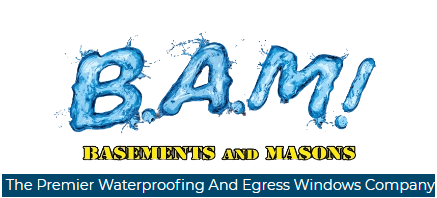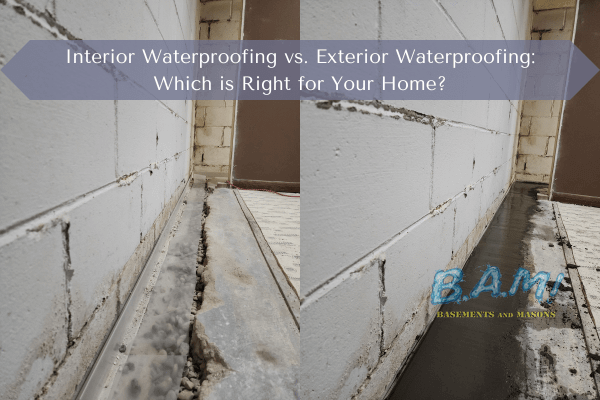Waterproofing is a crucial aspect of maintaining a healthy and functional home. Whether you’re dealing with a leaky basement or damp walls, addressing water in the basement is crucial to prevent damage and preserve the structural integrity of your property. When it comes to waterproofing, there are two primary methods: interior waterproofing and exterior waterproofing. Let’s explore the differences between the two approaches and help you determine which one is best suited for your specific needs.
Understanding Interior Waterproofing
Interior waterproofing involves implementing measures inside your home to manage water penetration. This method typically focuses on managing water after it has entered the structure. The primary goal of interior waterproofing is to divert water away from vulnerable areas and direct it towards drainage systems. Common techniques used in interior waterproofing include:
Interior Drainage Systems: This involves installing drains beneath the basement floor to collect and channel water away into a sump pump drain. The sump pump is often used to remove water from the basement to prevent flooding.
Vapor Barriers: These are moisture-resistant plastic sheets applied to the interior walls to prevent water vapor from seeping through.
Crack Repair: Leaks often occur through cracks in basement walls or floors. Interior waterproofing may involve sealing these cracks with epoxy injections or hydraulic cement to prevent water intrusion.
Advantages of Interior Waterproofing:
Cost-Effective: Interior waterproofing tends to be more affordable than exterior waterproofing since it doesn’t require extensive excavation or landscaping work.
Minimal Disruption: Since the work is primarily conducted inside the home, interior waterproofing causes minimal disturbance to your outdoor spaces and landscaping.
Faster Installation: Interior waterproofing projects can usually be completed more quickly than exterior methods, reducing the time your home is exposed to potential water damage.
Warranty: Comes with Limited Lifetime Warranties
Understanding Exterior Waterproofing:
Exterior waterproofing involves installing drainage outside of the foundation walls. It focuses on addressing water issues in the mud zone, typically through excavation and exterior surface treatments. Key techniques used in exterior waterproofing include:
Excavation and Waterproof Membranes: The first step in exterior waterproofing is excavating around the foundation to expose the exterior walls. Waterproof membranes or coatings are then applied to create a barrier between the foundation and surrounding soil.
French Drains: These are trenches filled with gravel and perforated pipes that collect water and divert it away from the foundation. They help alleviate hydrostatic pressure and prevent water from entering the basement.
Exterior Drainage Systems: Similar to interior drainage systems, exterior drainage systems collect water and redirect it away from the foundation. This includes the installation of gutters, downspouts, and proper grading.
Disadvantages of Exterior Waterproofing:
Cost: Exterior waterproofing is often more expensive compared to interior waterproofing methods. It involves excavation, installation of waterproof membranes, and backfilling, which can significantly increase the overall project cost.
Disruption and inconvenience: Exterior waterproofing requires excavation around the foundation of the building. This process can cause disruption to landscaping, driveways, and other outdoor structures. It may also require the temporary relocation of utilities such as gas, water, or electrical lines, leading to inconvenience for the occupants.
Time-consuming: Excavation and waterproofing the exterior of a building is a time-consuming process. It may take several days or even weeks to complete, depending on the size of the building and the extent of the waterproofing required. This can cause delays in construction or renovation projects.
Potential for damage: During the excavation process, there is a risk of damaging underground utility lines or the foundation itself. If not handled carefully, it can lead to additional repair costs and further delays.
Limited accessibility: Once the exterior waterproofing is installed, it becomes inaccessible for inspection or maintenance without further excavation. If any issues arise in the future, such as a leak or damage to the waterproofing membrane, it can be challenging and costly to access and repair the system.
Incomplete protection: While exterior waterproofing provides a barrier against water infiltration from the outside, it does not address water sources from within the building. If there are internal sources of water leakage, such as plumbing issues or condensation, additional measures may be needed to address those concerns.
Vulnerability to shifting soil: If the building is located in an area with expansive soil or frequent ground movement, exterior waterproofing systems may be more susceptible to damage. The movement of the soil can put stress on the waterproofing membrane, leading to cracks or breaches.
Warranty: No warranties for exterior waterproofing, as overtime the drainage will get clogged with soil again, causing you to need to do the waterproofing again.
Choosing the Right Method for Your Home:
The decision between interior and exterior waterproofing depends on various factors. Consider the following points to determine the most suitable approach for your home:
Source of Water: Assess where the water is coming from. If it is primarily seeping through cracks in the foundation walls, interior waterproofing will keep water out.
Warranty: Interior Waterproofing comes with limited lifetime warranties. Exterior waterproofing does not come with any warranty.
Contact the Basement Waterproofing Professionals
Waterproofing is a vital investment in the longevity and safety of your home. Whether you choose interior or exterior waterproofing, both methods have their advantages and serve specific purposes. Assess your unique needs, budget, and long-term goals to make an informed decision. It’s advisable to consult with a professional waterproofing company who can assess your property and recommend the best approach to protect your home from water damage. Remember, proactive waterproofing is key to maintaining a dry, healthy, and structurally sound living environment.
Allow the basement waterproofing system experts at BAM Basements and Masons to help you. We are one of the most sought-after names when it comes to basement waterproofing in and around Des Moines. Our team has many years of experience and in-depth knowledge about keeping the basement free from moisture and humidity. Therefore, we can suggest the right method for your home.
All our basement waterproofing techniques come at bargain basement pricing, and we ensure the timely completion of each of the projects. To know more about basement waterproofing and get a free estimate, please feel free to call us!

